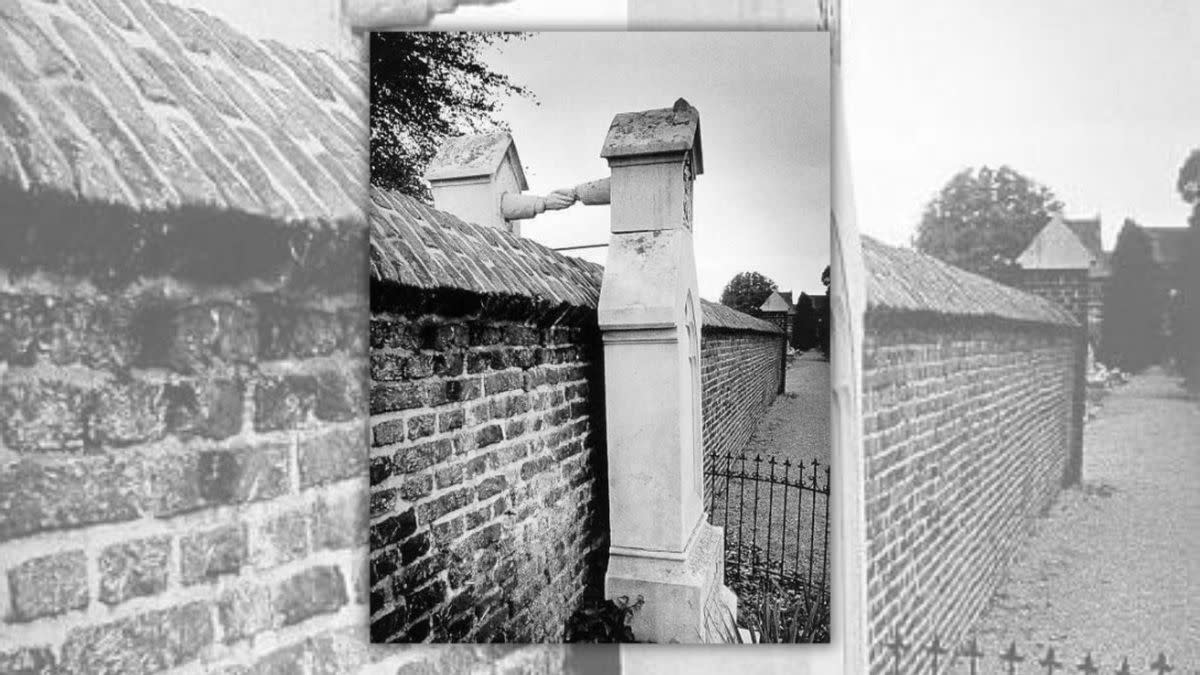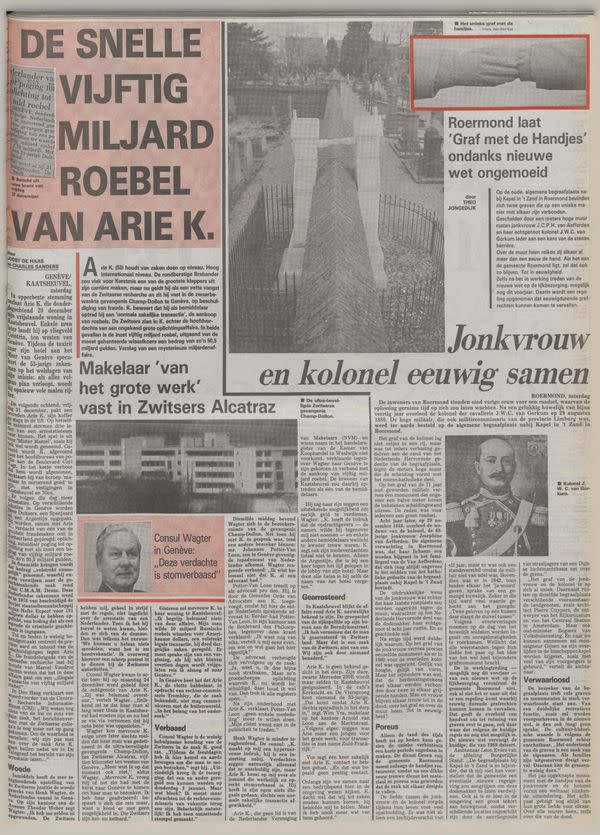Fact Check: About That Viral Pic Supposedly Showing Graves of Protestant Husband and Catholic Wife Not Allowed to Be Buried Together

Claim:
A photograph genuinely shows the gravesites of a Catholic wife and Protestant husband, situated in separate cemeteries because the couple was not permitted to be buried together.
Rating:
For years, a photograph allegedly showing the gravesites of two people, a Catholic and a Protestant, in separate cemeteries, has circulated online. Social media users claimed the photo showed a grave of a married couple barred from joint burial because their churches were of different denominations . "A protestant husband and Catholic wife were not allowed to be buried together in the same cemetery. Love finds a way. 1888," one X post with the photograph read.
A protestant husband and his catholic wife were not allowed to be buried together. Here are their headstones reaching across the two cemeteries in 1888. pic.twitter.com/8dviY2ic1G
— Fascinating (@fasc1nate) March 13, 2024
"Irish couple, one Catholic and one Protestant, who were buried in separate cemeteries but wanted to be together," another X post captioned the photograph. Google reverse-image search results showed that the photograph also spread on other social media platforms, such as Reddit, Pinterest, 9GAG, and Facebook. "Graves holding hands. Catholic woman and her Protestant husband who were not allowed to be buried together (1880s Holland)," a 2018 post with a similar photograph read. "Makes me sad to see that religion tries to seperate [sic] people even in death," one user commented under the post.
In short, the photograph is authentic and shows the so-called "Grave with the Hands" located in Roermond, Netherlands (not Ireland). When the husband, Jacobus Warnerus Constantinus van Gorkum, died in 1880, he was buried in the Protestant section of the cemetery. His wife, Josephine van Aefferden, who passed away in 1888, could not be buried with him due to the religious segregation in the cemetery at that time. Because of that, we have rated this claim as True.
Strictly speaking, they were buried in separate sections of the same cemetery, known as Kapel in 't Zand in Roermond, Netherlands, on opposite sides of a wall that divides the two sections by religion. The viral photograph shows a grave monument consisting of two parts situated on either side of that wall. We found its exact location via Google Maps:

(Google Maps)
The monument is registered in the Dutch National Register of Monuments. The register's website described it as a "grave monument consisting of two parts on either side of the cemetery wall that separate the Roman Catholic and Protestant parts of the cemetery" (we translated it using Google Translate):
JWC van Gorkum, Colonel of the Cavalry, Militia Commissioner in Limburg, is buried on the Protestant part. His wife Jonkvrouwe JCPH van Aefferden is buried on the Catholic part. The lady died eight years after her husband. Her grave monument reaches over the wall to her husband's grave monument. There is a semi-circular wrought iron fence around both grave monuments.
The website explained that both grave monuments consist of a sandstone column placed on a hardstone base. "The two hands, a woman's hand and a man's hand, symbolize the bond between both spouses after death and across the borders of different religions," the description continued, concluding that it serves as a special reminder of the wish of the wife and husband to remain connected after death, despite their different religions.
Similarly, Roermond's Old Cemetery Foundation wrote that "the mutual love between a Roman Catholic woman and a Protestant man after death is expressed in a very creative way."
We found an article with the title "Roermond leaves 'Tomb with the Hands' untouched despite new law" published in 1991 by De Telegraaf, the largest Dutch daily morning newspaper. We it accessed via Delpher, a website hosting digitized historical Dutch newspapers. The article informed that the graves remained "undisturbed despite the new law" (we translated it using Google Translate):
At the old general cemetery near Kapel in 't Zand in Roermond there are two graves that are connected in a unique way. Separated by a wall several meters high, the lady J.C.P.H. van Aefferden and her husband Colonel J.W.C, van Gorkum, each on one side of the stone barrier. They have been reaching out to each other across the wall for more than a century. If it is up to the municipality of Roermond, it will remain that way. Until eternity. Even after the new funeral law comes into effect, possibly this spring. This includes a provision that perpetual burial rights can lapse.

(delpher.nl)
"Lady and colonel together forever," the article continued, explaining in detail the history of the married couple. "After a happy marriage of almost forty years, the colonel of the cavalry J.W.C, von Gorkum, died on August 29, 1880. The high-ranking soldier, who was also militia commissioner of the province of Limburg, was buried at the general cemetery near Kapel in 't Zand in Roermond," it explained. "Eight years later, on November 29, 1888, the colonel's widow, the 68-year-old lady Josephine van Aefferden, died," it continued, explaining that the wife's grave was initially expected to be placed in a different part of the cemetery:
The general expectation in Roermond was that her body would be interred in the family grave of the Van Aefferdens, which is (still) located approximately in the middle of the Catholic section of the cemetery near Kapel in 't Zand. The express wish of the lady, however, was that her final resting place would be erected against the wall, behind which, in the Dutch Reformed part of the cemetery, her husband had been buried for eight years.
The article also reported that the love between the two "caused a lot of commotion during their lifetime," since theirs was a mixed marriage:
Not only was there an age difference of eleven years, but there was also a difference in status because the soldier was not of nobility. Moreover, in 1842, when both agreed to [marry] each other, there was talk of a mixed marriage. Especially at that time, much value was attached to the saying: "Two faiths on one pillow the devil sleeps between them." According to traditions, soldiers had to be deployed on the day of the wedding to prevent irregularities. Perhaps all the resistance to their love gave the couple the idea of the very special grave monument.
One Reddit user claimed that "It's not like there's a law against a Catholic and Protestant being buried next to each other. It's just the Catholic couldn't be buried at the Protestant church, and the Protestant couldn't be buried at the Catholic one. Most cemeteries affiliated with a religion make being that religion a requirement." In fact, an article with the title "The 'grave with the hands'" shared by an official website of Roermond's local authorities explained that in the 19th century it was customary that Catholics and Protestants were generally not allowed to be buried or interred in the same area of faith. The article also noted that some believe (though Snopes is unable to confirm) the remains of the couple actually do rest next to each other under a wall, as per the wife's undocumented but likely wishes, ensuring the couple remains together eternally:
It is believed that their remains are present under the foundation of the wall so that, despite all objections to their union, the spouses rest eternally next to each other after their death. It is assumed that the damsel had this method of burial recorded on paper, but to date no document referring to this has been found in archives. However, it is likely that Josephine van Aefferden discussed some things with her five children, who were all raised Catholic, and that her wish was carried out in this way. Neither man nor death could separate them.
Sources:
"Grave with the Hands · 6045 AR Roermond, Netherlands." Grave with the Hands · 6045 AR Roermond, Netherlands, https://www.google.com/maps/place/Grave+with+the+Hands/@51.1811281,5.9974293,17z/data=!3m1!4b1!4m6!3m5!1s0x47c0b4a645a416c9:0x37a883013bec77c0!8m2!3d51.1811248!4d6.0000042!16s%2Fg%2F12bffywbs?entry=ttu. Accessed 22 May 2024.
"Het 'graf met de handjes.'" Het 'graf met de handjes' — Gemeentearchief Roermond, https://www.archiefroermond.nl/nl/roermonds-verleden/verhalen/verhalen-rond-het-oude-kerkhof/het-graf-met-de-handjes. Accessed 22 May 2024.
"Historie." Stichting Oude Kerkhof te Roermond, https://www.oudekerkhofroermond.nl/historie/. Accessed 22 May 2024.
"Josephina Van Gorkum Broke the Rules by Marrying a Protestant. Here's How She Ensured Eternity with Him." Washington Post, 13 Jan. 2018. www.washingtonpost.com, https://www.washingtonpost.com/gender-identity/josephina-van-gorkum-broke-the-rules-by-marrying-a-protestant-heres-how-she-ensured-eternity-with-him/.
"Roermond Laat 'Graf Met de Handjes' Ondanks Nieuwe Wet Ongemoeid Door THEO JONGEDIJK Jonkvrouw En Kolonel Eeuwig Samen." De Telegraaf, Dag, 5 Jan. 1991. Delpher, https://resolver.kb.nl/resolve?urn=ddd:010646420:mpeg21:a1080.
Tegenover Weg Langs Het Kerkhof 1, 6045 AN Te Roermond | Rijksdienst Voor Het Cultureel Erfgoed. https://monumentenregister.cultureelerfgoed.nl/monumenten/520489. Accessed 22 May 2024.
Roermond laat 'Graf met de Handjes' ondanks nieuwe wet ongemoeid door THEO JONGEDIJK Jonkvrouw en kolonel eeuwig samen. "De Telegraaf". Amsterdam, 05-01-1991, p. 17. Geraadpleegd op Delpher op 22-05-2024, https://resolver.kb.nl/resolve?urn=ddd:010646420:mpeg21:p017



